solar panels
Latest

Tokyo will require new housing projects to install solar panels starting in 2025
Many new homes built in Tokyo will require solar panels to be installed starting in April 2025.
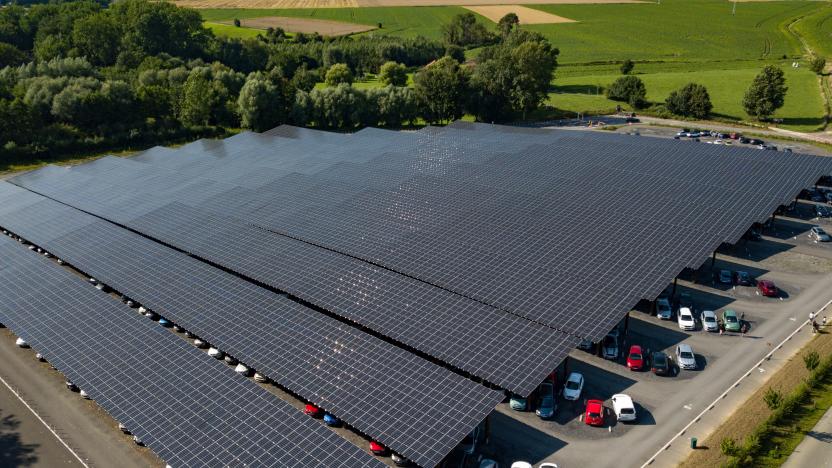
New French law will require parking lots to install solar panels
The French Senate has approved a bill that should increase that markedly, requiring parking lots with a minimum of 80 spaces to be covered by solar panels,
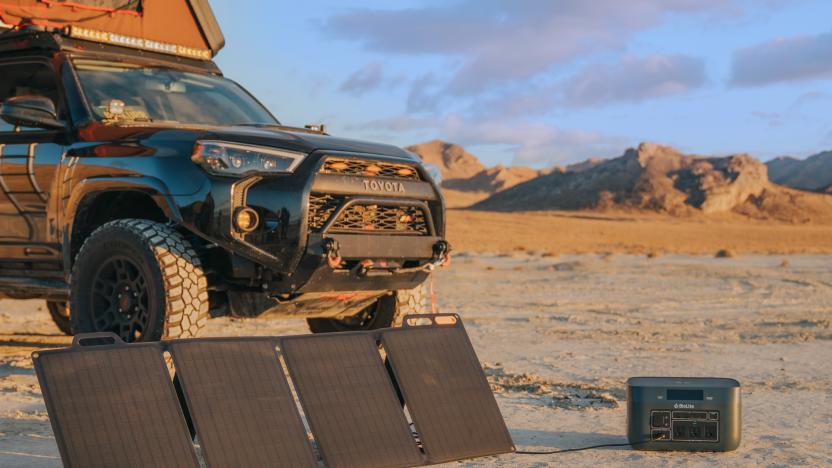
BioLite adds portable power stations and a solar array to its charging lineup
BioLite has just announced its new BaseCharge 600 and BaseCharge 1500 portable power stations, along with an accompanying SolarPanel 100.
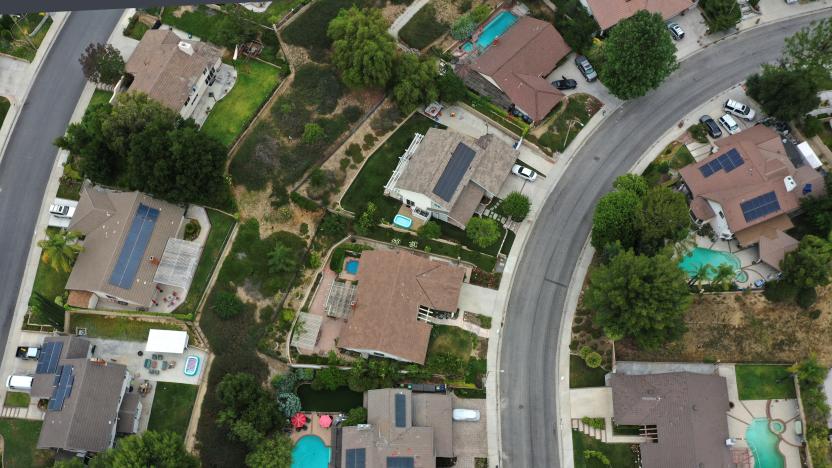
US energy department hopes instant permits will boost rooftop solar installations
The Department of Energy (DoE) has announced that it's rolling out a new tool that will make it much easier and faster to get a permit for a rooftop solar installation.

Scania is testing a solar truck trailer to see how much fuel it could save
A typical semi-truck trailer has the same surface as a medium-sized house. With that in mind, Volkswagen owned truck manufacturer Scania is is covering one of its trucks with 1,507 square feet of solar panels to see exactly how much fuel could be saved with its plug-in hybrid semi-tractor .
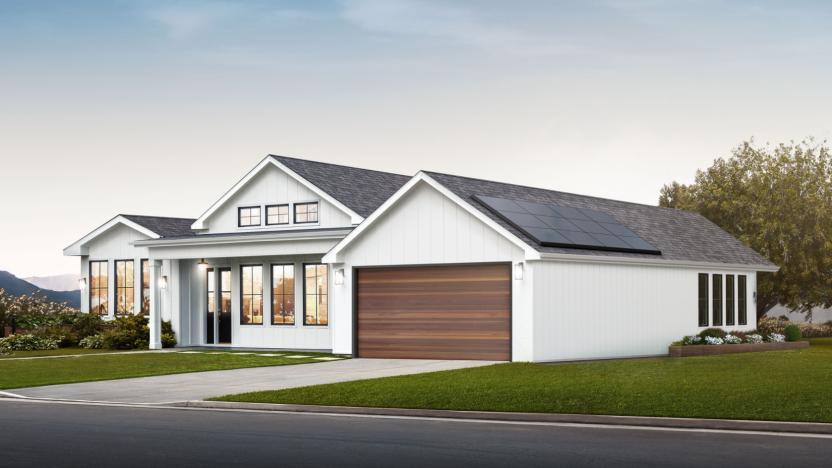
Tesla's solar panels are now more efficient and affordable
Tesla's solar panels are now about 10 percent more efficient. They're also more affordable.

Tesla unveils its easier-to-install Solar Roof
After spending a good amount of time talking about Tesla Energy during its earnings call earlier this week, the company announced its new Solar Roof tiles. According to CEO Elon Musk, if you need a new roof, installing these tiles will be cheaper than a new roof and separate solar panels.
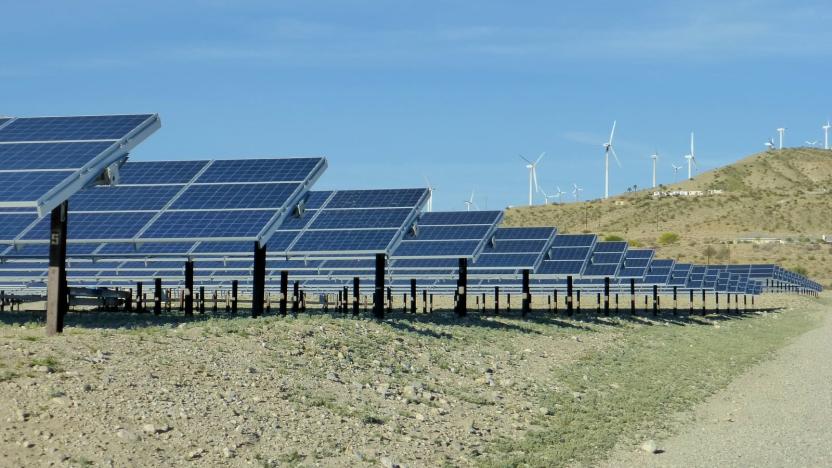
Recommended Reading: Replacing crops with solar panels
California farmers are planting solar panels as water supplies dry up Sammy Roth, Los Angeles Times In parts of California, water is becoming scarce, and that's not great news for farmers. There is an alternative though: solar panels. Los Angeles Times explains how the renewable energy source might help replace jobs and revenue that are lost as over half a million acres are taken out of production in the San Joaquin Valley alone.

Researchers boost solar energy by tapping infrared light
Our sun blasts out over 50 percent of its energy as "near-infrared" light, but solar cells only harvest visible light. As a result, the best commercial panels only convert about 20 percent of solar energy to electricity. Researchers from UC Riverside have now figured out how to "upconvert" infrared energy into much more useful visible light, a process that could make solar panels up to 30 percent more efficient. To do it, the team combined semiconductors with organic molecules, resulting in a material that essentially helped them "reshape the solar spectrum," according to lead researcher Christopher Bardeen.

RAVPower 15W Solar Charger, Savior battery pack keep your gadgets going
We're in the midst of winter in the Northern Hemisphere right now, but that doesn't mean that you can't start making plans for summer fun in the great outdoors. Today I'm reviewing two products that will keep your gizmos going. The first is designed to let you charge up anywhere, as long as the sun's out: the RAVPower 15W Dual-Port Solar Charger (List price US$99.99, available for $56.99). The second is targeted more for day-to-day use: the RAVPower RP-PB18 Savior External Battery Pack ($99.99, available for $49.99). RAVPower 15W Dual-Port Solar Charger I'm a fan of photovoltaic solar energy, so much so that my house here in sunny Colorado has a 9 kilowatt array on the roof. The RAVPower 15W Dual-Port Solar Charger is a lot smaller, both in size and capacity, but you don't need all that much power to charge your devices. The design is wonderful. You have a 24 ounce fabric folio covered with polyester canvas on the exterior that folds out revealing three separate panels. Located at four locations around the folio are metal-line eyeholes; these are used with carabiners (four are included) to attach the array to your backpack or a tent, or hang it from tree branches. There are two USB ports available, one with a 2A output, the other with a 1A output. Both, of course, send out that current at the USB standard 5 volts. RAVPower uses what they call "iSmart Technology" to match the maximum charging current with the device so that it is charged in the least amount of time. To test the review device, I unfolded the Solar Charger and put it on an outside table next to my iPhone 6 Plus to see how much of a charge it would pick up in just ten minutes. Of course, the charging time is going to depend on a variety of factors - cloud cover, angle of the sun, time of day, and so on. The when I plugged the iPhone 6 Plus into the Solar Charger, it immediately responded with notification that it was charging. I shut the iPhone's display off, waited ten minutes, and then turned the display back on. During that time, it grabbed 4 percent more power, climbing from 89 percent charged to 93 percent charged. It's not a scientific estimate, but based on that information, that the Solar Charger could fully charge an iPhone 6 Plus from 0 to 100 percent in a little over four hours. Remember, this was with late afternoon sun in the winter... so it could be faster under other conditions. Chances are good that you will want to use the Solar Charger with some sort of external battery pack so that you can still use your device during daylight hours, which is why the next portion of this review is about the RAVPower RP-PB18 Savior External Battery Pack. Conclusion The well-built RAVPower 15W Dual-Port Solar Charger has a surprisingly low price point compared to competing portable solar arrays, and is a perfect accessory for camping, hiking, picnics and bicycling. Rating: 4 stars out of 4 stars possible RAVPower RP-PB18 Savior External Battery Pack The Savior series external battery pack is a perfect all-in-one travel companion, featuring a wall plug, a 9000 mAh battery, and a built-in Lightning Connector. It comes in black or white, and there's a USB output port as well for charging those older Apple devices or other gadgets that take power from mini or micro USB. Unlike most of these products, RAVPower throws in some nice goodies; a carrying bag to protect the exterior of the battery pack, a USB to micro-USB cable, a micro-USB to mini-USB adapter, and a micro-USB to 30-pin Dock connector adapter. RAVPower received Apple MFi (Made for iPad/iPhone/iPod) certification for the device, so you can rest assured that it will work properly with any of your Apple mobile devices. The Lightning cable provides power to your iPhone or iPad at a maximum current of 2.4A for fast charging, while the USB port has a maximum current of 1 A. The entire package weighs about 8.63 ounces (237 grams) and is compact at 1.1 inch thick x 2.76 inches wide by 4.49 inches tall (28 x 70 x 113 mm). One feature that you won't find on many of RAVPower's competitor's external battery packs is the Grade A+ cell that's inside the pack. It has no charging memory effect, and can be used through up to 1,000 charging cycles. Conclusion With a built-in AC plug, Lightning cable, USB port, a 9,000 mAh long-life battery, a variety of USB plug adapters, and a carrying bag, the RAVPower RP-PB18 Savior is a perfect traveling companion at a very reasonable price (the $50 price tag). Rating: 4 stars out of 4 stars possible Giveaway TUAW and RAVPower are giving away the RAVPower RP-PB18 Savior External Battery Pack. Here are the rules for the giveaway: Open to legal US residents of the 50 United States, the District of Columbia and Canada (excluding Quebec) who are 18 and older. To enter, fill out the form below completely and click or tap the Submit button. The entry must be made before January 27, 2015 11:59PM Eastern Standard Time. You may enter only once. One winner will be selected in a random drawing and will receive a RAVPower RP-PB18 Savior External Battery Pack valued at $99.99. Click Here for complete Official Rules. Loading...

Fraunhofer black silicon could catch more energy from infrared light, go green with sulfur
Generating solar power from the infrared spectrum, or even nearby frequencies, has proven difficult in spite of a quarter of the Sun's energy passing through those wavelengths. The Fraunhofer Institute for Telecommunications may have jumped that hurdle to efficiency through sulfur -- one of the very materials that solar energy often helps eliminate. By irradiating ordinary silicon through femtosecond-level laser pulses within a sulfuric atmosphere, the technique melds sulfur with silicon and makes it easier for infrared light electrons to build into the frenzy needed for conducting electricity. The black-tinted silicon that results from the process is still in the early stages and needs improvements to automation and refinement to become a real product, but there's every intention of making that happen: Fraunhofer plans a spinoff to market finished laser systems for solar cell builders who want their own black silicon. If all goes well, the darker shade of solar panels could lead to a brighter future for clean energy.

Sharp unveils semi-transparent solar panels, lets you see the sun while reaping its benefits
Sharp has announced an unusual photovoltaic panel for the Japanese market that collects energy from the sun while still allowing the light to shine on through. Though it's rated at a lowly 6.8 percent / 98 watt max efficiency, the glass-like properties make it useful as a construction material (as shown in the balcony railing above), with the semi-transparent nature giving occupants privacy, to boot. The energy-producing cells are embedded in a laminated glass structure and an air slot provides a thermal barrier, allowing the panels to also be used as "windows, curtain wall and eaves" according to Sharp's PR. Though the system won't win any potency prizes, it has garnered a design award in Japan, so it won't blight any landscapes. There's no mention of pricing or western availability so far, but you can hit the source for all the technical details.

IBM alliance sets efficiency record for solar power cells using common materials
There have been more than a few solar power efficiency records set in the past few months, let alone years. What makes IBM, DelSolar, Solar Frontier and Tokyo Ohka Kogyo think they can just waltz in and claim a record of their own? By using more commonplace elements in the periodic table, that's how. The partnership's new photovoltaic cell based on copper, zinc and tin (CZTS for short) can convert light rays to electric power with a 11.1 percent efficiency rate -- still nothing to upset traditional silicon power, but a large 10 percent more efficient than anything else in the class. In its early form, CZTS can already be manufactured through ink printing and could be produced in quantities equivalent to about 500 gigawatts of power per year, or five times more than some of the next-closest alternatives. The group wants to improve CZTS' efficiency over the course of the next several years, ideally reaching the point where it's useful as a truly cheap, ubiquitous source of power. We're looking forward to the day when there's a little slice of solar energy in just about everything, hopefully including a few more hybrid cars and private aircraft.

Researchers make unsuitable parts work as solar cells, could lead to cheaper panels
Harnessing the power of the sun is a tricky business, but even the past few weeks have seen some interesting developments in the field. In this latest installment, researchers from the Lawrence Berkeley National Laboratory and the University of California have figured out a way of making solar cells from any semiconductor, potentially reducing the cost of their production. You see, efficient solar cells require semiconductors to be chemically modified for the current they produce to flow in one direction. The process uses expensive materials and only works with a few types of semiconductors, but the team's looking at using ones which aren't normally suitable -- the magic is to apply an electrical field to them. This field requires energy, but what's consumed is said to be a tiny fraction of what the cell's capable of producing when active, and it means chemical modification isn't needed. The concept of using a field to standardize the flow of juice isn't a new one, but the team's work on the geometrical structure of the cells has made it a reality, with a couple of working prototypes to satisfy the skeptics. More of these are on the way, as their focus has shifted to which semiconductors can offer the best efficiency at the lowest cost. And when the researchers have answered that question, there's nothing left to do but get cracking on commercial production. For the full scientific explanation, hit up the links below.

3D, light-trapping solar cells successfully fabricated by Solar3D
Solar3D probably isn't a company you're particularly familiar with... at least not yet. The California-based manufacturer has just successfully fabricated a three dimensional solar panel that traps sun light in nano-scale wells on a silicon wafer. Perhaps most exciting, the prototype panel was built using off-the-shelf tech from Panasonic, meaning that the price of mass production shouldn't be prohibitively high. More testing is needed, but the resulting panels should be up to 50 percent more efficient than current generation 2D ones. For a few more details, check out The PR after the break.

Alt-week 7.8.2012: Solar flares, trapping dark matter, and life-sized Lego trees
Alt-week peels back the covers on some of the more curious sci-tech stories from the last seven days. This week we swing by some superhero news, look at how solar panels might shape up in the future, explore a Lego forest and see how to grab dark matter just using some household gold and strands of DNA. Not only that, we discover how the sun likes to celebrate the fourth of July with its own firework display. This is alt-week

Logitech unveils its Solar Keyboard Folio for the new iPad and iPad 2, we go hands-on
There are all sorts of ways to go green these days, from driving an EV to installing super efficient light bulbs, and now Logitech's given us an environmentally friendly way to type tactilely on a tablet. It's a new iPad and iPad 2-friendly case called the Solar Keyboard Folio, which packs a Bluetooth keyboard powered by ambient light using the same solar cell tech found on the firm's computer keyboards. Once topped up with photons, Logitech claims its battery will keep you typing for over 1,000 hours even in complete darkness. The case is crafted of black, soft-touch, faux leather embossed with a small Logitech logo and has perforations for the iPad's speakers, plus a portal for the tablet's camera. Its keyboard is made of gray plastic, and pecking at the grid is a similar experience to using the one found on Logitech's other recently released iPad typing peripheral, the Ultrathin Keyboard Cover. Buttons are short-throw and provide satisfying clicky feedback, but the space bar and shift keys have a hollow feel when pressed. Perhaps the Folio's most intriguing design feature is the feet on the corners of the cradle in which the iPad is placed. Those little nubs allow for two viewing angles -- your slate can be seated in a more upright position behind the keyboard for typing, or in the notches outside the two shift keys for a more obtuse viewing angle when the keyboard isn't needed. What's this bit of green gear cost? It goes on sale in the US and Europe this month with an MSRP of $130.

Tesla pairs up with SolarCity, will power off-grid homes as well as cars
If you've ever dreamed of thumbing your nose at big energy and its expensive, polluting ways, then Tesla and a solar panel leasing company called SolarCity might be taking you a baby-step closer to reality. Although recognized mostly for its EVs, Tesla reckons it knows enough about batteries to solve a key problem in the solar energy chain -- namely the storage of power for use when the sun, power grid, or both go offline. The battery design, consisting of many laptop-style lithium ion batteries stacked together, was chosen after two years of research and a $1.8 million energy grant. The two companies are now waiting for tax credits from the Fed and California before rolling out the tech. And being kissing cousins -- with Elon Musk as both Chairman of SolarCity and CEO of Tesla -- certainly can't hurt.

Researchers create incredibly thin solar cells flexible enough to wrap around a human hair
You've probably heard that the sun is strong enough to power our planet many times over, but without a practical method of harnessing that energy, there's no way to take full advantage. An incredibly thin and light solar cell could go a long way to accomplishing that on a smaller scale, however, making the latest device from researchers from the University of Austria and the University of Tokyo a fairly significant discovery. Scientists were able to create an ultra-thin solar cell that measures just 1.9 micrometers thick -- roughly one-tenth the size of the next device. Not only is the sample slim -- composed of electrodes mounted on plastic foil, rather than glass -- it's also incredibly flexible, able to be wrapped around a single strand of human hair (which, believe it or not, is nearly 20 times thicker). The scalable cell could replace batteries in lighting, display and medical applications, and may be ready to be put to use in as few as five years. There's a bounty of physical measurement and efficiency data at the source link below, so grab those reading glasses and click on past the break.

Nanoshells trap light for more efficient solar panels
Scientists at Stanford are hard at work trying to improve the efficiency and durability of solar panels -- two key factors that have kept the Sun from becoming a more popular source of energy. Their latest effort involves nanocrystalline-silicon, a material that has proven resilient and highly conductive, but not very good at absorbing light. Their solution, nanoshells -- hollowed out spheres of silicon that trap and recirculate light much like a whispering gallery does sound. Balls of the crystalline material are dipped in silicon, then hydrofluoric acid is used to eat way the center of the sphere, leaving a path for light to enter. The shells trap the light, allowing more of it to be absorbed, and also reduces the effect of non-optimal angles on energy production. Hit up the source for a few more details.











